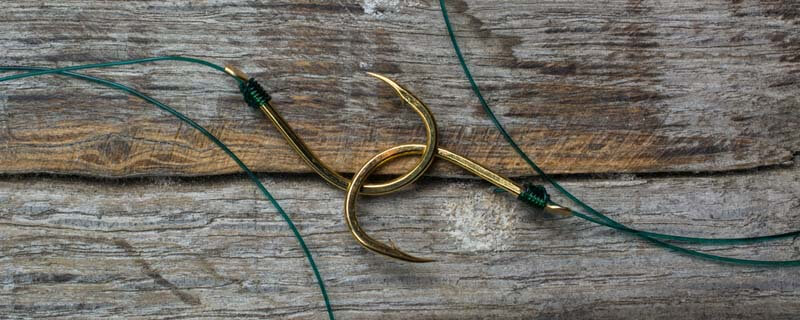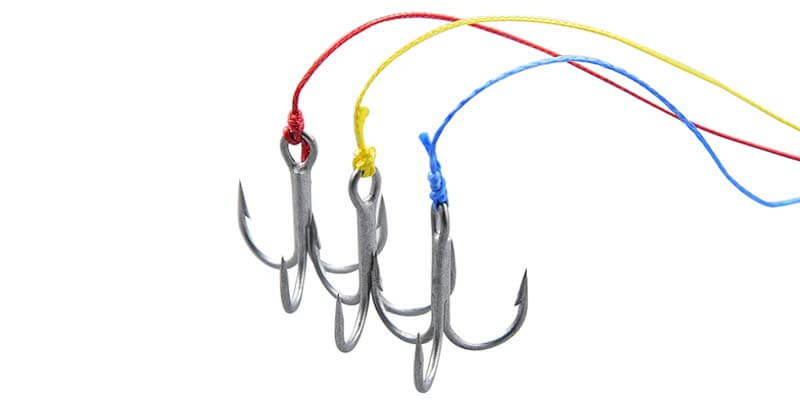When you want to use braids, you need to learn how to tie braided fishing line with various knots. This is because the conventional mono knots you know will not be useful if you need to know how to tie fishing knots with braided lines. As either a beginner or professional angler, it is vital you know how to perform simple fishing tasks like tying a braided fishing line.
If you want your fishing expedition to be successful, you need to be familiar with almost all the fishing line tying methods. In this guide, I have taken ample time to explain some important knot types used to tie a braided fishing line. They are very simple knot types to learn.
The Upgraded Palomar Knot
The upgraded Palomar knot is not the conventional Palomar knot you might be used to. This type of knot is ideal for linking your braid to a lure, swivel or hook. And the exciting part is, it is fast and easy to tie. When you tie this knot, it is stronger than the regular Palomar knot for braided lines.
The first step to tying the upgraded Palomar knot is to form a loop at the braid’s tag end to get a doubled line of around 5-6 lines. Then, thread the new loop via the hook’s eye twice. To make it easier, squeeze the loop’s end to make a point. After this, draw the mainline and the double tag end for the loops to remain tight on the lure’s eye.
Also, wrap the double tag end around the mainline to create an overhand knot; do this twice. The double tag end should be wrapped around the mainline, top to bottom, and wrapped towards the lure/hook. Draw the mainline and double tag to make the knot on the eye tightened, thereby creating a loop.
Ensure the double line tag end makes a loop with the same width as the lure/hook. Next, thread the lure/hook via the tag-line loop and take it above the eye. It would be effortless to achieve with hooks but difficult with big lures. Lastly, moisturize the line and firmly draw the tag-end and mainline till the loop is tightly fixed within the eye, then prune the tag-end.
The Surgeon’s Knot
If you want to know how to tie mono to braided fishing line, you need to use the surgeon’s knot. It is effortless to tie, and when you’re done, it is strong. For this knot, the first step to tying the braided line is to trim the mono leader to your preferred length.
Then, ensure the lines overlap to be placed side-by-side (The perfect overlap length should be between 8-9 inches). In a single hand, pinch both lines together. However, leave around 1 to 2 inches of the mono leader, which points to the braid’s mainline. Then, create a loop, leave the leader at the braid’s tag end, which comes out on either side.
Next, wrap the braid’s tag-end and the leader through the loop; do this 6 to 8 times. Take the leader and the braid’s tag end in one hand, and the braid’s mainline and the leader’s tag end in another hand. Then, draw them away for the knot to close up a bit.
After that, apply moisture to the knot and repeat the step, pulling the lines tight. When you’re done, release the tag-ends, then tightly pull the braid’s mainline and the leader. Ensure you pull tightly to create a neat knot. Lastly, trim the tag-ends.
The Braided Uni Knot

If you want to tie a braid to a swivel, this is one of the ideal knots to use. Furthermore, they are great for lures and hooks. The Uni Knot for tying braided line is slightly dissimilar from the conventional Uni Knot. Hence, if you are familiar with the Uni for Mono knot, it would be easy-easy to tie this knot.
The exciting part about tying this knot is, it is easy, neat and strong. To tie the braided Uni Knot, thread the line through the hook, swivel or lure’s eye. Then, draw out around an 8-inch thread for the tag end. Again, thread the line to double it, then pull tight. This step is what primarily differentiates the braided Uni knot from the normal one.
Next, create a loop in the mainline region with the tag end. When you do this, it forms a loop where half of it is made from the tagline and the mainline. Also, wrap the tag end via the loop around 10-12 times from the end of the loop and away from the hook. While at this, ensure the wraps are in one direction, and the length of your tag end determines the ease of completing this process.
Furthermore, draw the lure/swivel/hook in one direction and the mainline and the tag-end in the other direction. Ensure you pull tight till the knot starts to coil in the lure/swivel/hook direction and stops. After the knot coils, release the tag-end and make the line wet. Then, pull very tightly till the knot rests on the eye. Immediately, trim the tag-end.
Also Read: How to Tie Two Fishing Lines Together – Best Tips for You
The Albright Knot
One of the proficient knots to use when learning how to tie a knot with braided fishing line is the Albright knot. This knot comes in handy when you need to connect a braid to a mono leader. The Albright knot is straightforward and quick to tie, and it is firm. If you want to make the Albright knot firmer and smoother, you can coat it with rubber cement.
To start tying the Albright Knot, create a loop in the mono-leader. Then, run the braid’s end through the loop. Next, create a neat wrap of the braid around the loop and itself, from top to bottom, ten times. Also, run the end back via the loop on the same route as to when the braid initially went in. Lastly, wet the knot and pull it tight before trimming the tag-ends.
Reasons Why Braided Fishing Lines Are Great

Some professional anglers prefer using braided fishing lines for various reasons. And if you are familiar with monofilament fishing lines, you will not know why these anglers would instead use the braided fishing lines.
1. The Abrasion Resistance Is High
If you opt for a top-quality braided line, you can be sure that you would not be replacing it anytime soon. One of the ideal means to save costs is to invest in a quality material that would stand the test of time. The braided fishing line comes with a high abrasion resistance that prevents it from breaking when exposed to ultraviolet light.
Most fishes cannot break the line, but some species like pike have teeth that can cut through the braids. With this, your braided fishing line can undoubtedly last for a very long time in and out of use.
2. It Has Little or No Stretch
If you want to enjoy deep water fishing, the braided fishing line is ideal for you. In deep waters, it would be seamless for you to have a feel of bites. More so, because braided fishing lines have a small diameter with little or no stretch, you can take your crankbaits deeper in water.
Since braided fishing lines do not have stretch, it makes it easy to fish lures on long casts. The absence of stretch in your braided fishing line enables you to suitably set the hook with lots of fishing line.
3. High Strength to Size Ratio
It is imperative to mention that one of the braided fishing line’s primary strengths is its high strength to size ratio. This feature helps to increase the reel’s capacity, and it aids in reducing the total weight of your fishing gear.
4. When Wet, the Breaking Strength Remains Constant
Unlike fishing lines like the monofilament model, which significantly reduces strength when it is wet, the braided fishing line does not experience that. Monofilament lines of lower quality experience a strength loss of 20-30% when they are in the water.
In comparison, the braided fishing lines do not take in water. This attribute is one reason why their breaking strength when dry is equally the same when wet.
5. They Float
The beauty of using braided fishing lines is that they float compared to monofilament fishing lines, which sink when they are in the water. If you want to use braided fishing lines and top-water baits, your work is made easier.
6. They Are Great for Fishing in Thick Vegetation.
If you need the ideal fishing line to fish in heavy or thick vegetation, you need the braided fishing line. These braids have the capacity to pass through lily pads, cattails, hydrilla and any aquatic encumbrance. With this feature, the fish is prevented from being tangled. If you use a monofilament line in thick vegetation, it would be a different story because you will most likely lose the fish.
Also Read: Best Fluorocarbon Lines for A Fishing Expert!
Conclusion
One of the facts you need to know when learning how to tie braided fishing line is it lasts longer than fluorocarbon and monofilament. The braided fishing line exudes more strength than fluoro and mono, even at the same thickness level.
You will also enjoy the braided fishing line because it exhibits a higher sensitivity level than other lines. Mastering the various knots needed to tie a braided fishing line is highly beneficial when fishing because it aids you to capture more fishes both in freshwater and saltwater.

